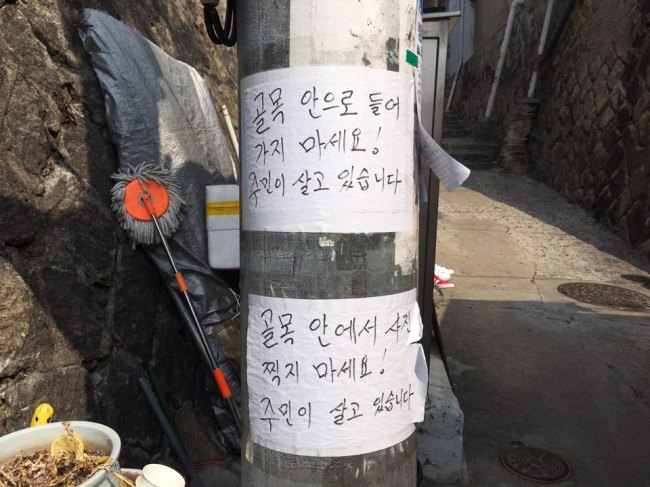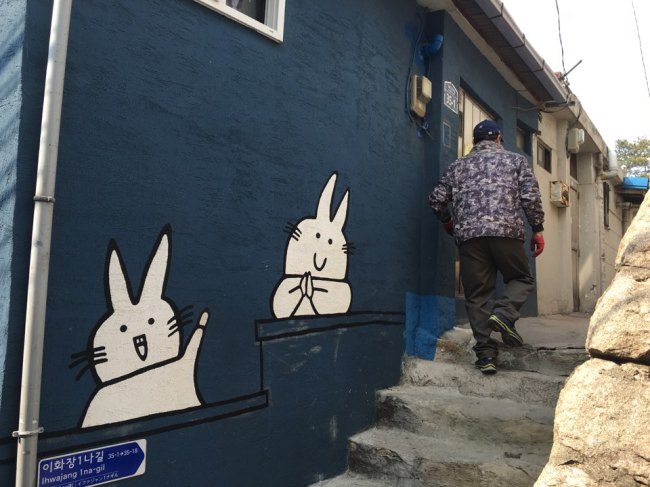Ihwa-dong, located near Naksan Park in the northern part of central Seoul, is a quaint community which used to be a dull shantytown a decade ago.
In 2006, with the help of the Ministry of Culture and Tourism, the community transformed itself through what they called the “Naksan Project.” A total of 68 artists gathered to paint walls and install sculptures. An ordinary village soon turned into a booming tourist spot.
Despite its off-the-beaten-path location, the mural village has become overcrowded with local and foreign tourists, artsy cafes and stores. But the popularity of the village is not so welcomed by residents.
“All those coffee shops prospered but they’re run by outsiders who come in to make money,” said a woman surnamed Koo, a resident of Ihwa-dong for 30 years.
“To be honest, villagers here don’t see any advantages. Noise and trash are what’s left behind ever since our home became a mural village,” Koo added.
 |
Signs posted on a pole in Ihwa-dong read, “Do not enter the alley,” “Do not take pictures inside the alley. There are people living here.” (Kim Da-sol/The Korea Herald) |
There are about 10 mural villages in Seoul, each operated and supervised by the autonomous district office and its public design division.
In response to residents’ complaints over privacy and littering, Jongno-gu has run the “Silent Campaign” since 2013, which aims to spread a quiet and nonintrusive sightseeing culture.
“We hand out leaflets and put up posters to promote the campaign. At the tourist information center, we play animated videos to help visitors understand that the (mural) village is also someone’s home,” said Lee Sun-min from Jongno-Gu’s tourism division.
However, residents in the area say that their voice should be heard more and that such themed villages should not be established without regulations.
“I don’t know what the district office is doing for us. No single trash bin is installed in our village. Newly painted stairs and walls actually do not provide us a better quality of life,” said Yoo, 78, who runs a corner shop in Ihwa Mural Village.
 |
A resident walks into his home where the wall is painted with a mural in Ihwa-dong. (Kim Da-sol/The Korea Herald) |
“I wake up early at 5 a.m. in the morning to clean up the street. All I ask is for visitors not to leave their trash on the fence or in between windows,” Yoo added.
“Or maybe, residents (here) will have to ask authorities to erase the murals,” she said.
In 2010, a popular local TV show “One Day Two Nights” featured a mural of two white angel wings in the village. After the show aired, the house with the mural of angel wings was inundated by visitors which eventually led to the resident removing the artwork.
By Kim Da-sol (
ddd@heraldcorp.com)
[한글판]
관광객들이 버린 쓰레기는 주민들 몫? 구청은 시종일관 “쓰레기통 추가 설치 없다”
‘이화동 달동네’라는 이름이 더 익숙했던 이화벽화마을 주민들에게 지난 10년간 많은 변화가 생겼다.
줄지어 마을 곳곳에서 사진을 찍는 관광객들이 평일에도 넘쳐났고, 골목 어귀마다 카페와 먹을거리를 파는 가게들이 들어섰다.
하지만, 그 중 가장 큰 변화는 바로 사라진 공용 쓰레기통과 관광객들이 집 앞, 창틀 사이, 담벼락 위에 놓고 간 쓰레기들이었다.
실제로 기자가 14일 낮 찾아가 본 이화벽화마을에는 테이크아웃용 플라스틱 컵, 종이컵, 휴지, 대학로에서 받아온 팸플릿 등 온갖 쓰레기들이 “쓰레기통 없는 마을” 곳곳에 버려져 있었다.
주민들은 언제부턴가 골목 군데군데 있던 공용 쓰레기통이 사라진 이유를 모르겠다며 불편함을 호소했다.
마을 초입에서 슈퍼를 운영하고 유 모 (78)씨는 더는 동네 곳곳에 쓰레기가 쌓이는 것을 볼 수 없다며 직접 종이박스를 두어 관광객들이 플라스틱 컵이나 쓰레기를 버릴 수 있는 간이 쓰레기통을 가게 앞에 놓기도 하였다.
하지만, 유 모 씨에게 돌아온 것은 16만 8천 원의 벌금을 부과한 종로구청의 통지서였다.
이에 종로구청 관계자는 “이는 쓰레기 무단 투기를 줄이려는 구의 방침”이라며 “도시 비우기 사업의 일환으로 꼭 필요한 데가 아니면 쓰레기통을 없앨 것”이라고 말했다.
서울시 자료에 따르면 종로구에 설치된 가로휴지통의 수는 매년 감소하는 추세다. 2014년 자료에 따르면 관광객 인구 수가 높은 종로구에는 총 129개의 공용 쓰레기통이 설치되어 있다. 이는 공용 쓰레기통 1개를 구민 1,282명이 사용하는 셈이다. 최근 약 900여 개의 쓰레기통을 추가로 설치한 강남구와 비교했을 때, 구민 671명당 1개의 쓰레기통을 사용하는 강남구의 약 두 배 정도 되는 숫자이다.
종로구 관계자는 이화벽화마을이 종로구의 유명 관광지 중 한 곳으로 수많은 관광객을 맞이하고 있음에도 “무단 투기를 막고자 추가 쓰레기통 설치에 대한 계획은 없다”라고 일관했다.
코리아 헤럴드/김다솔 기자 (
ddd@heraldcorp.com)









![[Today’s K-pop] Blackpink’s Jennie, Lisa invited to Coachella as solo acts](http://res.heraldm.com/phpwas/restmb_idxmake.php?idx=644&simg=/content/image/2024/11/21/20241121050099_0.jpg)